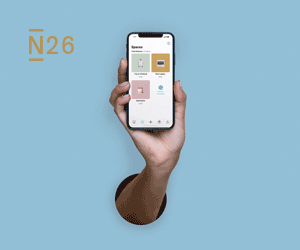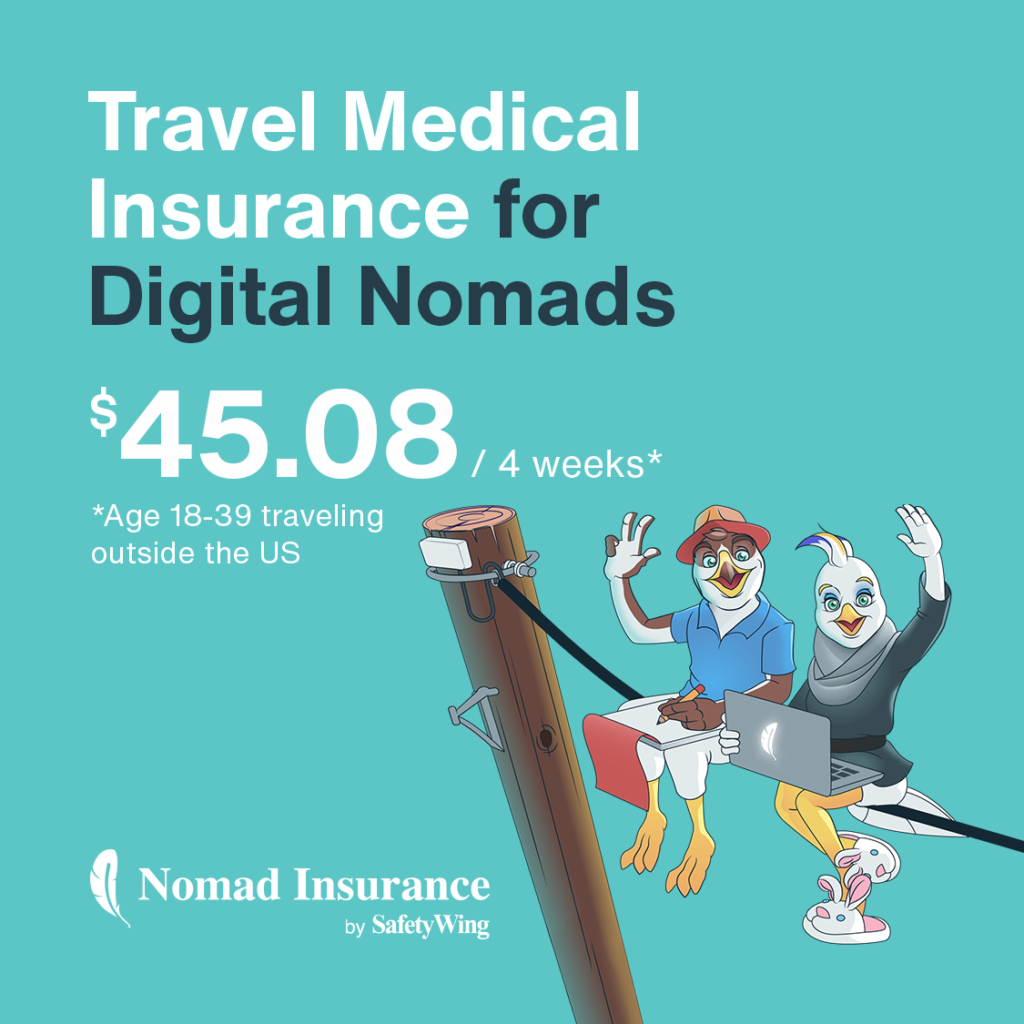If you’re starting your journey as a digital nomad, you might be wondering what you’re going to do with your money. (What a fun problem to have!)
Living abroad (or even traveling overseas) sounds great, but what about ATM fees? And currency exchange rates? Is there any way to avoid them?!
In this post, we’re talking about the best banks for digital nomads and travelers.
There’s one thing to consider though – it truly depends on where you’re from. And it can be quite annoying, actually. There are several options for European citizens, but some options can be limited for others (for example, Canadians).
So, I made some research to find out what are the best nomad banks for expats and digital nomads. Obviously, these solutions can work perfectly for travelers too.
Before we start let’s talk about a few important things to note about digital nomad banking. (I know, it’s the most interesting topic here, but it is quite important.)
Why is banking for digital nomads so important?
Even if most nomads would prefer to look for their next flights instead of travel bank cards, banking still is an important topic. I, myself, lived in many countries over the years. I paid enormous ATM fees, wire transfer fees, etc.
When I was living in the United Kingdom, my bank blocked my card twice in five months, and unfortunately, Canadian banks can’t unblock cards over the phone, so there I was, waiting for my new card to come. It was a nightmare, to be honest.
Imagine if I had been in Asia. With dodgy post offices and letters that never reach their destinations, I could have been a very long time without any bank cards. Even though I was living in the United Kingdom, it still took a while to get my bank card.
But that’s not all.
What happens when you handle multiple currencies? When you’re constantly on the move? When you need to get paid? Nobody wants to have to pay regular banking fees.
These are simple reasons why you should consider having more than one bank account or at least one that is favorable to your lifestyle.
If you’ve been following me for a while, you know I’ve been living in Southeast Asia for several years. I now use several banking methods, and oh, my life is easier.
Keep reading to learn more about your options, and at the end, I’ll share exactly what banking systems I’m using.
Best Nomad Bank Options For Digital Nomads And Expats
Looking for the best options for travel cards and bank accounts for digital nomads? Here are the best nomad banks to consider this year.
I wouldn’t be surprised to see more and more options in the upcoming months too.
Charles Schwab Bank
There is a resounding love for this bank by many US digital nomads, which is why it needed to be added to our best digital nomad banking list. Charles Schwab tends to be the number one choice due to the many attractive features of its checking account.
Why people love it: They refund international ATM fees! This is the most alluring perk to banking with Charles Schwab and saves you so much money, especially if you like to hop frequently between countries with different currencies.
Things you might not love: Not only do you need to be an American resident, but you also need to be in the country while opening the account, even if you are doing it online. So, if you’re a US citizen and you’re still planning your upcoming trips, it’s the perfect time to open your bank account.
N26
N26 is a company that started in Germany, expanded across Europe, and is working on supporting US residents. They are known as direct banks or branchless banks, meaning that they only exist digitally. From opening an account to controlling your funds, you never have to wait in a financial center again.
Why people love it: Other than the fact that it is all online and you have a 24 hours customer support; N26 takes care of your foreign transaction fees which makes them an ideal choice for digital nomads. It’s one of the best digital bank accounts available so far.
Things you might not love: One of the biggest concerns of a solely direct bank comes the question of safety. Customers have fallen victim to phishing frauds in early 2019, which were quickly corrected by N26. This was likely due to the quick growth of the company and didn’t necessarily mean that they are more susceptible to attacks than any normal bank. Apart from that, N26 isn’t open to everyone (Canadians can’t register there for now). My boyfriend is European, and he had trouble in certain destinations, such as Morocco with his N26 card. Again – that comes back to your bank method diversification!
Revolut
Revolut works a lot like STACK (the next one on this list) but has a few more developed features like N26. It is an excellent option for European residents looking for a nomad bank account and is run with an uncomplicated app that you can get on your iPhone or Android device.
Why people love it: With Revolut, you can store up to five different currencies within your account and withdraw them from any ATM around the world. Although, if you’re Canadian, you’ll be sad to know that after two years of the beta program, Revolut had to close its program in Canada.
Things you might not love: Revolut isn’t available for everyone. So if it’s not working in your country, you may need to look into different options.
STACK
A new option for Canadian digital nomads is the STACK Prepaid Mastercard. Some people might not be too keen on signing up for something like this but STACK offers some beneficial perks with its program.
Why people love it: Not only do they not have any monthly, ATM, or international transfer fees, it is also free to add money onto the card. You can also sign up for the card online, so no waiting in a banking institution just to set it up.
Things you might not love: Although you can use STACK around the world easily, it only supports Canadian currency and therefore limits how you can add money into your STACK account. Although it is very easy, you can only add money onto your card through an e-transfer from your Canadian bank account or in person at a Canada Post Office.
Monese
Monese is similar to N26 and Revolut. Working via an app, Monese allows you to have a GBP or a EUR account. It’s quite a new player in the banking industry for digital nomads. In fact, they only started in 2017. Once again, Monese is only available for European citizens.
Why people love it: You can easily track all your banking details within the app. They will also send you notifications when you receive or spend money, which means it’s safe. Finally, you can use your card abroad without fees.
Things you might not love: This option is only available for European residents. Keeping in mind Monese is quite a new player in the industry, we aren’t 100% sure about the safety and all.
Wise
One of the up-and-coming international transfer companies is Wise. It was developed to combat the high transfer fees that we are hit with every time we need to pay ourselves or send money home.
Why people love it: Wise offers the lowest fees when sending and receiving large amounts of money (over $1000). You can also obtain a Wise bank card which is helpful. It’s a great way to get paid since the fees are super low! They recently launched their Wise cards for Canadians. Click here to learn more.
Things you might not love: With only 48 countries that you can send money to and less that you can receive from, Wise lacks the freedom of where your money can go. The card option only works for residents from certain countries.
PayPal
PayPal is the most prominent digital banking platform and is well-known around the world. The company was first established with a goal of creating a global currency but ended up narrowing in on the idea of easy money transferring between countries.
Why people love it: Since PayPal is one of the pioneering companies for digital transferring, it has developed its service to support over 200 countries, and 25 different currencies.
Things you might not love: Unlike some other companies, PayPay charges a percentage instead of a flat rate for their transfers, which can add up for larger transfers. They also tend to increase their fees regularly, which means you’re losing more and more money.
Payoneer
As one of the newest digital banking options, Payoneer has created a solid client list that includes the likes of Airbnb and Fiverr. They have a vast network that supports 150 local currencies around the world.
Why people love it: Payoneer charges a flat rate of $3 per transfer. You can also order a card which is quite helpful.
Things you might not love: Payoneer has built itself to cater more to large businesses and e-commerce channels, which means that as someone who is a small freelancer, you might end up paying more in fees. Also, if you order the card, the fees related to this card are pretty high.
My Digital Nomad Banking System
Like I said at the top of this article, I’m willing to share my nomad banking system. So, let’s see what I have and how I usually get paid.
- I have my “normal” Canadian bank card that I haven’t used since I got my Revolut card. Although, most of my money stays there and I can transfer it easily to my Revolut account. Now that my Canadian account is closing with Revolut, I’ll still be able to remain at Revolut since I’m a European resident.
- I have my Revolut card (I have the Metal one), which I can use for low ATM withdrawal fees and pay my freelancers.
- I use Paypal to get paid for certain clients since it’s one of the most common options out there. While the fees are high, it’s still the easiest way to get paid fast since almost everyone uses it.
- I use Payoneer to get paid from Amazon Affiliates.
- I use Wise to get paid by certain clients and to pay my freelancers/team members. I recently ordered a Canadian Wise Bank Card.
- I use Stripe as a payment platform where people can pay using their credit cards – you can also send invoices, or people can buy your services this way. For example, I sell digital products using Stripe.
Final Thoughts On Banking For Digital Nomads
As you can see, there are several options when it comes to bank accounts for digital nomads.
I recommend using 2 or 3 different banks at once to avoid problems and always to have alternatives in case of emergencies abroad.
Want more tips for digital nomads? Read one of the following blog posts:



